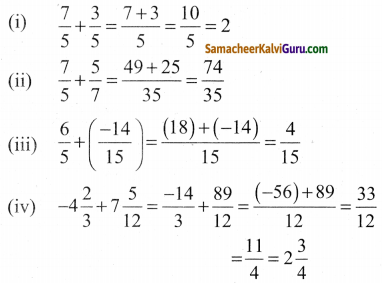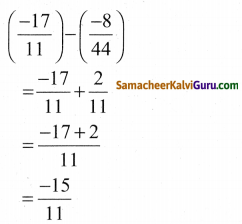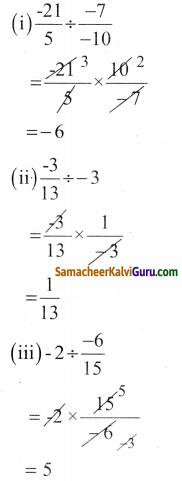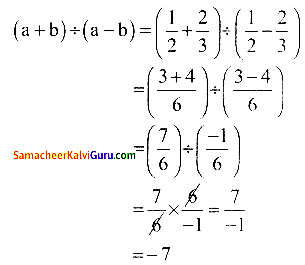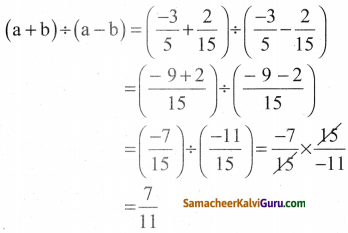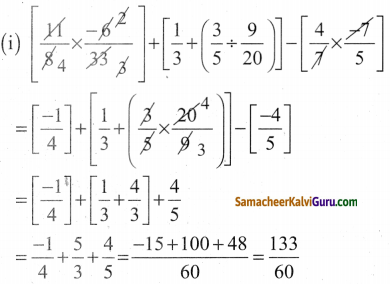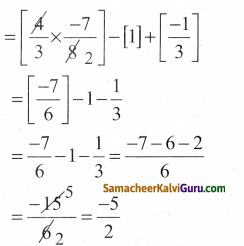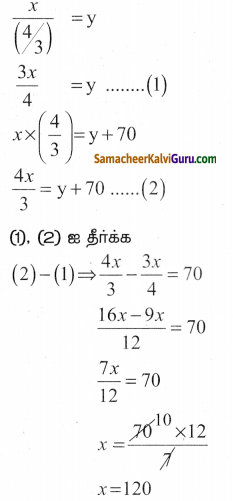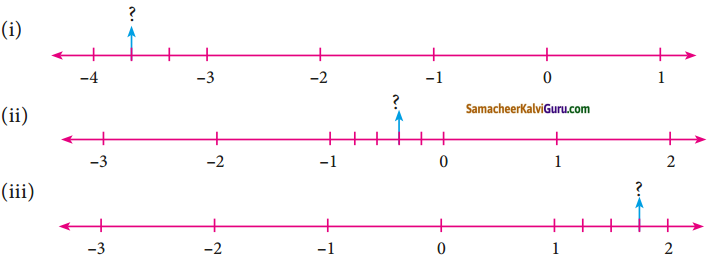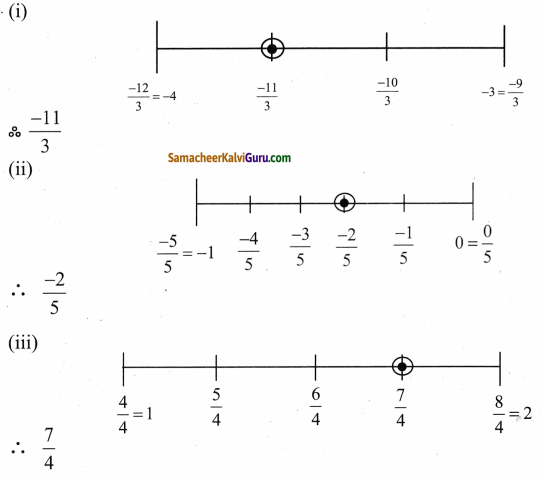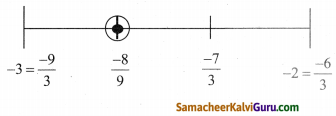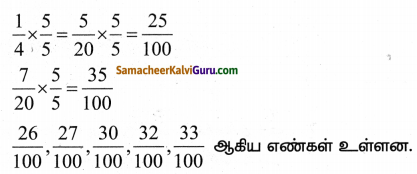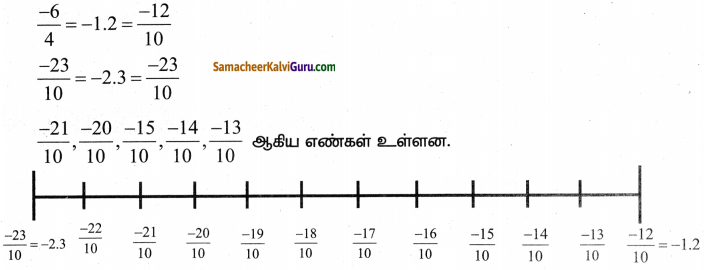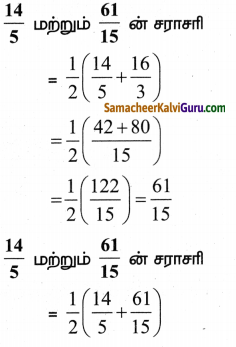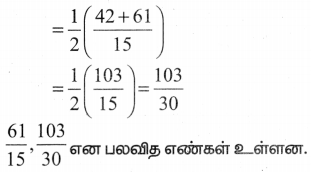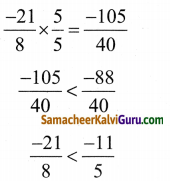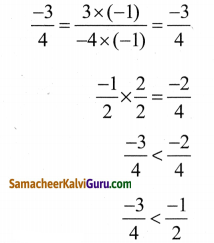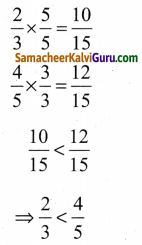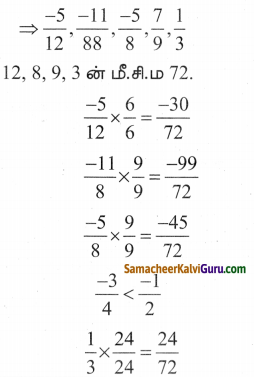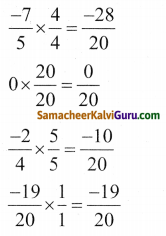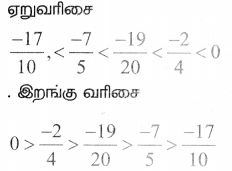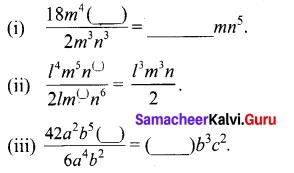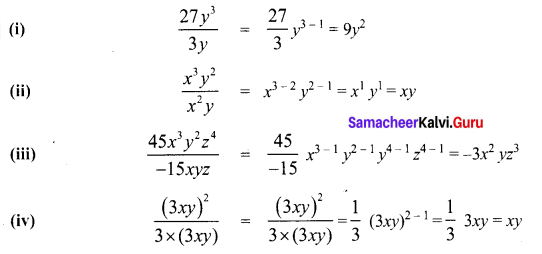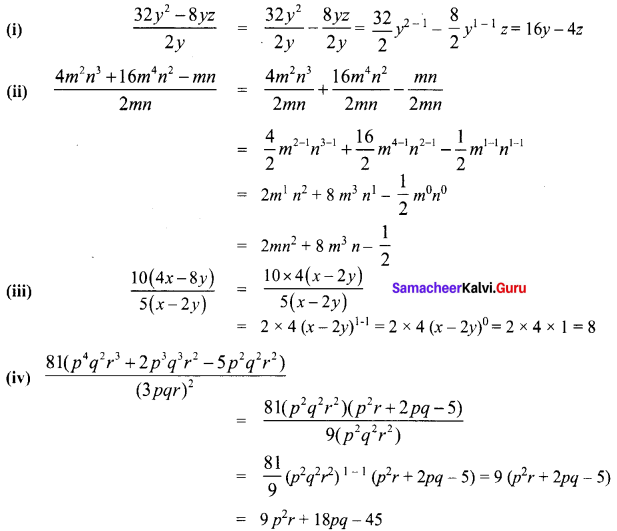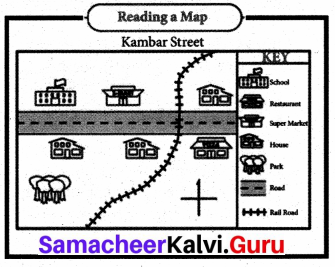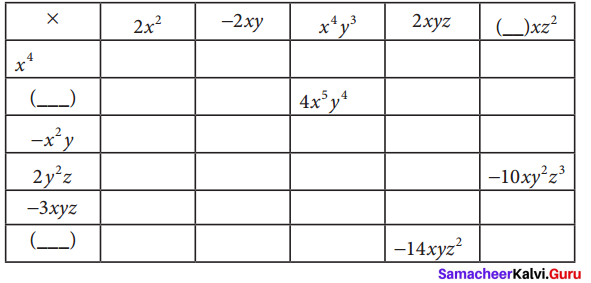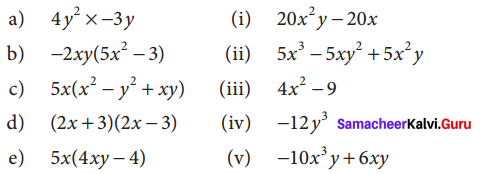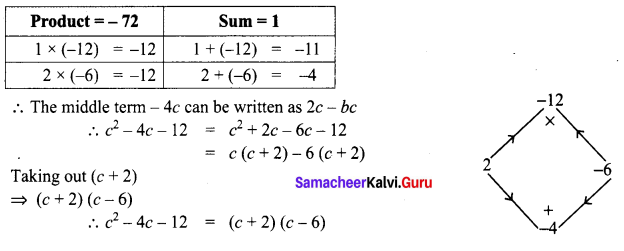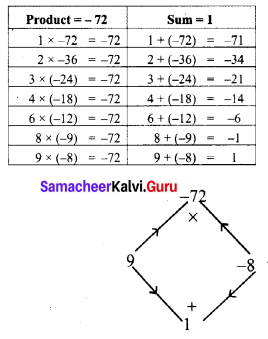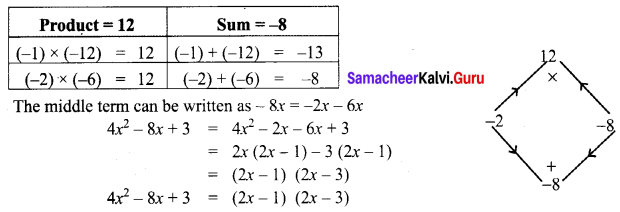Tamilnadu State Board New Syllabus Samacheer Kalvi 8th Maths Guide Pdf Chapter 1 எண்கள் Ex 1.3 Textbook Questions and Answers, Notes.
TN Board 8th Maths Solutions Chapter 1 எண்கள் Ex 1.3
கேள்வி 1.
\(\frac{-5}{7}\) மற்றும் \(\frac{8}{9}\) ஆகிய விகிதமுறு எண்களுக்குக் கூட்டல் மற்றும் பெருக்கலுக்கான அடைவுப் பண்பினைச் சரிபார்க்கவும்.
தீர்வு :
a = \(\frac{-5}{7}\), b = \(\frac{8}{9}\) என்க
a + b = \(\frac{-5}{7}+\frac{8}{9}=\frac{-45+56}{63}=\frac{11}{63}\) ∈ Q
ab = \(\frac{-5}{7} \times \frac{8}{9}=\frac{-40}{63} \mathrm{Q}\)
![]()
கேள்வி 2.
\(\frac{-10}{11}\) மற்றும் \(\frac{-8}{33}\) ஆகிய விகிதமுறு எண்களுக்குக் கூட்டல் மற்றும் பெருக்கலுக்கானப் பரிமாற்றுப் பண்பினைச் சரிபார்க்கவும்.
தீர்வு :
கூட்டல் பரிமாற்றுப் பண்பு
a + b = b + a
இடப்பக்கம் = a+b =
\(\left(\frac{-10}{11}\right)+\left(\frac{-8}{33}\right)=\frac{(-30)+(-8)}{33}=\frac{-38}{33}\)
வலப்பக்கம் = b+a= \(\left(\frac{-8}{33}\right)+\left(\frac{-10}{11}\right)=\frac{(-8)+(-30)}{33}=\frac{-38}{33}\)
பெருக்கல் பரிமாற்றப் பண்பு. இடப்பக்கம்
a x b = \(\left(\frac{-10}{11}\right) \times\left(\frac{-8}{33}\right)=\frac{80}{363}\)
வலப்பக்கம்
= b x a = \(\left(\frac{-8}{33}\right) \times\left(\frac{-10}{11}\right)=\frac{80}{363}\)
இடப்பக்கம் = வலப்பக்கம்
கேள்வி 3.
\(\frac{-7}{9}, \frac{5}{6}\) மற்றும் \(\frac{-4}{3}\) ஆகிய விகிதமுறு எண்களுக்குக் கூட்டல் மற்றும் பெருக்கலுக்கானச் சேர்ப்புப் பண்பினைச் சரிபார்க்கவும்.
தீர்வு :
a = \(\frac{-7}{9}\) b = \(\frac{5}{6}\) மற்றும் C = \(\frac{-4}{3}\)
கூட்டல் சேர்ப்பு பண்பு :
a + ( b + c ) = (a + b) + c
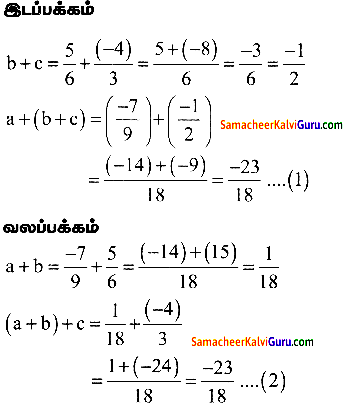
(1), (2) லிருந்து a+(b+c)=(a+b) + c நிரூபிக்கப்பட்டது.
இடப்பக்கம் = வலப்பக்கம்
பெருக்கல் சேர்ப்பு பண்பு :
a x (b x c) = (a x b) x c
இடப்பக்கம்
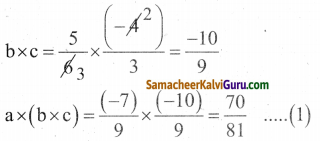
வலப்பக்கம்
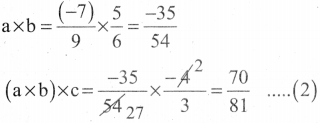
(1), (2) லிருந்து
a x (b x c) = (a x b) x c நிரூபிக்கப்பட்டது இடப்பக்கம் = வலப்பக்கம்
![]()
கேள்வி 4.
விகிதமுறு எண்களுக்கான a x (b + c)= (axb) +(a x c) என்ற பங்கீட்டுப் பண்பினை a = \(\frac { -1 }{ 2 }\)
b = \(\frac { 2 }{ 3 }\), c = \(\frac { -5 }{ 6 }\) ஆகிய விகிதமுறு எண்களுக்கு சரிபார்க்கவும்.
தீர்வு :
பங்கீட்டுப் பண்பு
a x (b+c) = (a x b) + (a x c)
இடப்பக்கம் ⇒ b + c
\(\frac{2}{3}+\frac{(-5)}{6}=\frac{4+(-5)}{6}=\frac{-1}{6}\)
வலப்பக்கம் a x (b+c)
= \(\left(\frac{-1}{2}\right) \times\left(\frac{-1}{6}\right)=\frac{1}{12}\)
வலப்பக்கம்
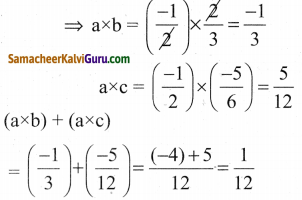
இடப்பக்கம் = வலப்பக்கம்
கேள்வி 5.
கூட்டல் மற்றும் பெருக்கலுக்கான சமனிப் பண்பினை \(\frac { 15 }{ 9 }\) மற்றும் \(\frac { -18 }{ 25 }\) ஆகிய விகிதமுறு எண்களுக்குச் சரிபார்க்க வும்.
தீர்வு :
a = \(\frac { 15 }{ 9 }\), b = \(\frac { -18 }{ 25 }\)
கூட்டலுக்கான சமனிப் பண்பு
0 + a = a + 0 = a
இடப்பக்கம்
= 0 + a = 0 + \(\frac { 15 }{ 9 }\) = \(\frac { 15 }{ 9 }\) = a
வலப்பக்கம்
= a + 0 = \(\frac { 15 }{ 9 }\) + 0 = \(\frac { 15 }{ 9 }\) = a ……. (2)
(1), (2) லிருந்து
0 + a = a + 0 = a
0 + b = b + 0 = b
இடப்பக்கம்
= 0 + b = 0 + ( \(\left(\frac{-18}{25}\right)=\frac{-18}{25}\) ) = b ……………… (1)
வலப்பக்கம்
= b + 0 = \(\left(\frac{-18}{25}\right)+0=\frac{-18}{25}\) = b ……………. (2)
(1) & (2) லிருந்து 0 + b = b + 0 = b
பெருக்கலுக்கான சமனிப்பண்பு :
1 x a = a x 1 =a
இடப்பக்கம் = 1 x a = 1 x \(\frac{15}{19}=\frac{15}{19}\) = a ….. (1)
வலப்பக்கம் = a x 1 = \(\) = a ………(2)
(1) & (2) லிருந்து 1 x a = a x 1 = a
1 x b = b x 1 = b
இடப்பக்கம்
1 x b = 1 x \(\left(\frac{-18}{25}\right)=\frac{-18}{25}\) = b …………………(1)
வலப்பக்கம்
= b x 1 = \(\left(\frac{-18}{25}\right) \times 1=\frac{-18}{25}\) = b ……………….(2)
(1) & (2) லிருந்து
1 x b = b x 1 = b
![]()
கேள்வி 6.
கூட்டல் மற்றும் பெருக்கலுக்கான நேர்மாறு பண்பினை \(\frac { -7 }{ 17 }\) மற்றும் \(\frac { 17 }{ 27 }\) ஆகிய விகிதமுறு எண்களுக்குச் சரிபார்க்கவும்.
கூட்டலுக்கான நேர்மாறு பண்பு :
தீர்வு :
a + (-a) = 0 = (-a) + a
a = \(\frac { -7 }{ 17 }\) b = \(\frac { 17 }{ 27 }\)
இடப்பக்கம் = a + (-a)
\(\left(\frac{-7}{17}\right)+\left(\frac{7}{17}\right)=\frac{-7+7}{17}=\frac{0}{17}\) = 0 ….(1)
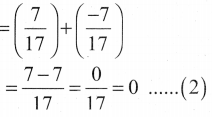
(1) & (2) லிருந்து a + (-a) = 0 = (-a) + a
(ii) இடப்பக்கம் = b + (-b)
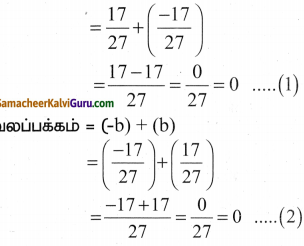
(1) & (2) லிருந்து b + (-b) = 0 = (-b) + b
பெருக்கலுக்கான நேர்மாறு பண்பு :
a x \(\frac{1}{a}=\frac{1}{a}\) x a = 1
(i) இடப்பக்கம் =
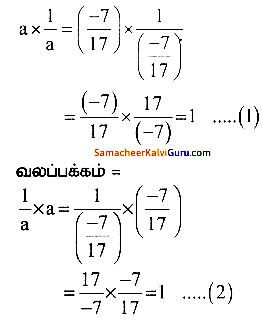
(1) & (2) லிருந்து
a x \(\frac{1}{a}=\frac{1}{a}\) x a = 1
(ii) இடப்பக்கம் =
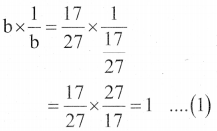
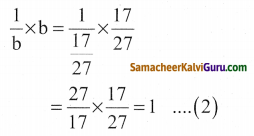
(1) & (2) லிருந்து
b x \(\frac{1}{b}=\frac{1}{b}\) x b = 1
![]()
கொள்குறிவகை வினாக்கள்
கேள்வி 7.
விகிதமுறு எண்களுக்கு, ………. என்ற எண்ணால் அடைவுப் பண்பானது வகுத்தலுக்கு உண்மையாகாது.
(அ) 1
(ஆ)-1
(இ) 0
(ஈ) 1/2
விடை :
(இ) 0
கேள்வி 8.
\(\frac{1}{2}-\left(\frac{3}{4}-\frac{5}{6}\right) \neq\left(\frac{1}{2}-\frac{3}{4}\right)-\frac{5}{6}\) என்பது, கழித்தலானது, விகிதமுறு எண்களின் ……… பண்பினை நிறைவு செய்யாது என்பதை விளக்குகிறது.
(அ) பரிமாற்று
(ஆ) அடைவு
(இ) பங்கீட்டு
(ஈ) சேர்ப்பு
விடை :
(ஈ) சேர்ப்பு
![]()
கேள்வி 9.
பின்வருவனவற்றுள் எது கூட்டலின் நேர்மாறுப் பண்பினை விளக்குகிறது?
\(\frac{1}{8}-\frac{1}{8}\) = 0
\(\frac{1}{8}+\frac{1}{8}=\frac{1}{4}\)
\(\frac{1}{8}+0=\frac{1}{8}\)
\(\frac{1}{8}-0=\frac{1}{8}\)
விடை :
\(\frac{1}{8}-\frac{1}{8}\) = 0
கேள்வி 10.
\(\frac{3}{4} \times\left(\frac{1}{2}-\frac{1}{4}\right)=\frac{3}{4} \times \frac{1}{2}-\frac{3}{4} \times \frac{1}{4}\) என்பது, பெருக்கலானது …………….. இன் மீது பங்கீடு செய்கிறது என்பதை
விளக்குகிறது.
(அ) கூட்டல்
(ஆ) கழித்தல்
(இ) பெருக்கல்
(ஈ) வகுத்தல்
விடை :
(ஆ) கழித்தல்
